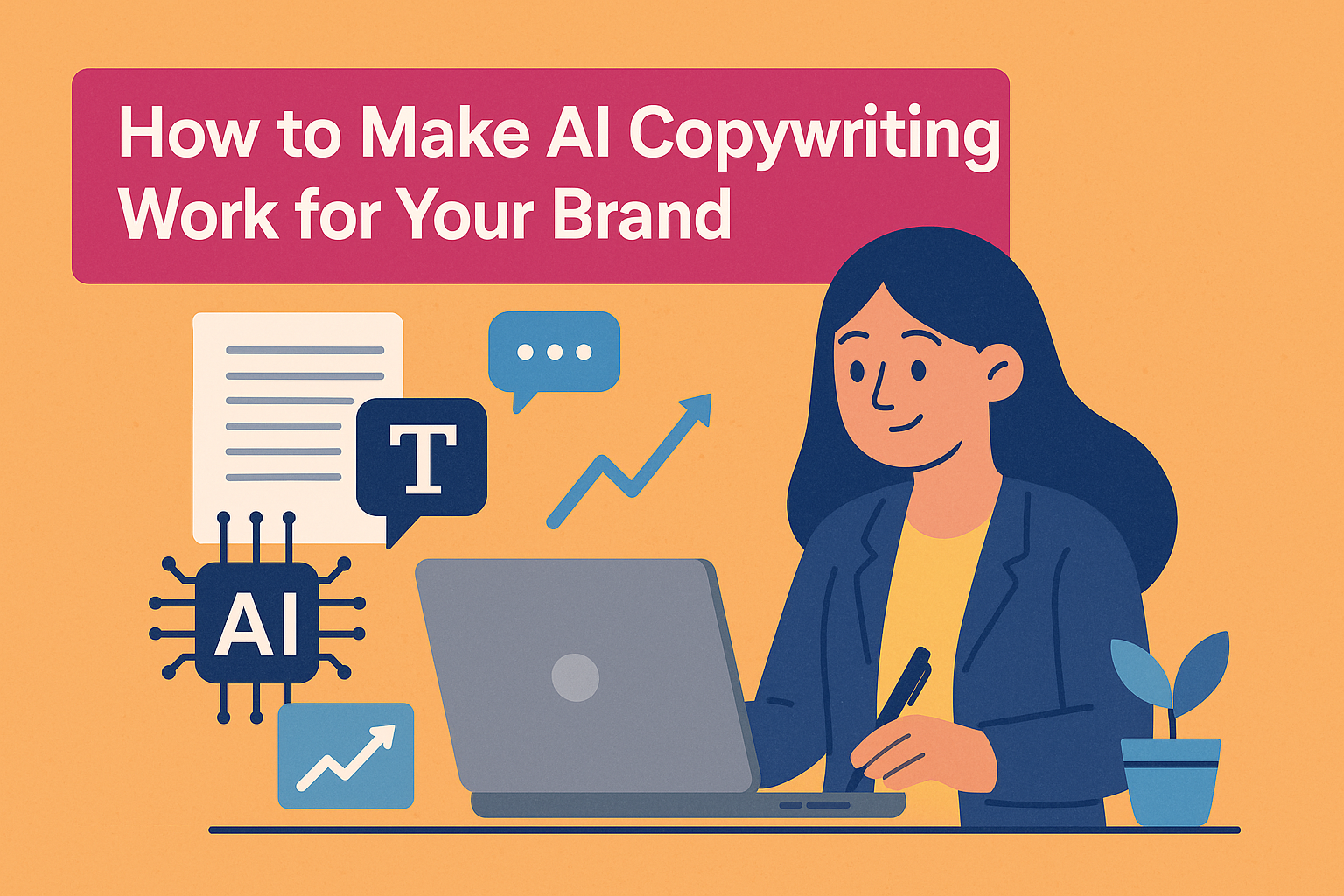The hype around AI copywriting tools like ChatGPT, Jasper, or Copy.ai is deafening. Scroll through LinkedIn or Twitter, and you’ll see wild claims like “Write 30 blog posts in an hour!” or “Never hire a copywriter again!” But here’s the truth most businesses are quietly discovering:
AI copywriting isn’t magic.
And it won’t work—unless you work it the right way.
Used right, AI is a force multiplier. Used wrong, it’s a content mill that pumps out generic fluff your audience scrolls past.
This blog breaks down exactly how to make AI copywriting actually work for your brand—no fluff, no hype. Just a strategy-rich guide grounded in what seasoned marketers and conversion copywriters do behind the scenes when they use AI tools.
1. First, Ditch the Myth: AI Doesn’t Replace Human Strategy
Let’s clear the air.
AI can write.
But it doesn’t know why it’s writing.
It doesn’t know your customer. It doesn’t understand your brand values, your offer structure, your positioning, or your tone—unless you teach it. AI is essentially a hyper-efficient intern with amnesia. It can draft fast. But without strategy, it’s useless.
Most Business Owners Get This Wrong:
They type something like:
“Write me a blog post about email marketing”
And what do they get?
A generic, surface-level article with tips everyone’s heard: “Personalize your emails,” “Use catchy subject lines,” etc.
AI is only as smart as your inputs. If your prompt is vague, your output will be worthless.
2. The Prompt Is the Blueprint: Garbage In, Garbage Out
A high-quality AI output starts with a strategic prompt. Think of it like giving an architect instructions:
- Weak input: “Build me a house.”
- Strong input: “Design a two-story modern farmhouse with open living space, 4 bedrooms, natural light, and a wraparound porch, for a family of five.”
Same with AI prompts.
Prompting Done Right:
Before you even prompt, gather this info:
- Audience profile: Who are you writing to? What do they fear, want, avoid?
- Tone of voice: Friendly? Authoritative? Casual? Spiritual?
- Offer context: What’s the CTA? What is the product or service behind the copy?
- Platform/purpose: Blog post? Ad copy? Landing page?
- Keyword or SEO intent (if applicable)
Better Prompt Example:
“Write a blog post (1,500 words) targeting small business owners who are overwhelmed by content marketing. Focus on how AI copywriting can save them time without sacrificing brand voice. Use a friendly, expert tone and include practical examples.”
Now you’re giving the AI a framework. This is the single biggest shift most brands miss.
3. Don’t Publish First Drafts—Refine Like a Copy Chief
AI-generated content is never ready out of the box.
Treat it like a rough draft from a junior copywriter: there might be gold inside, but it needs refinement. Editing is where your human brain steps in.
What You Should Edit For:
- Brand-specific language – Does it sound like you?
- Unique value props – Has it included what you uniquely offer?
- Emotional resonance – Does it hit the right pain points and desires?
- CTAs and conversion structure – Is it leading somewhere, or just rambling?
- Originality – Is this a regurgitation of what’s already online?
Seasoned marketers will re-prompt AI multiple times or even feed it sections from past high-converting content to “train” it mid-session.
4. Feed It Your Brand Voice and DNA
If you want AI copywriting to feel like your brand, you have to treat AI like a trainee. That means feeding it:
- Samples of your existing copy
- Voice guidelines (e.g., “We don’t use jargon. We use short, punchy sentences. Never passive voice.”)
- Examples of what not to write
How to Train Your AI:
Create a prompt like:
“You’re a copywriter for [Brand Name]. Our tone is bold, irreverent, and deeply empathetic. We don’t talk like corporations—we talk like humans. Here’s a sample of how we write [paste your brand copy]. Based on this, write a new version of the following blog intro…”
This one strategy alone can 3x the quality of your AI outputs.
5. Use AI for Speed, but Guide It with Structure
AI excels at ideation and structural writing—but only if you break things down.
Rather than say, “Write an entire article,” try:
- “Give me 10 blog title ideas targeting freelancers who are burned out.”
- “Now turn #4 into a detailed outline with subheadings.”
- “Write the intro paragraph based on the outline and include a pain point.”
Break the job down. That’s what pro copywriters do, too.
They don’t write a final headline out of nowhere. They brainstorm 50. They structure, then rewrite. AI follows the same logic.
6. Combine AI with Real Research
This is where most brands go wrong.
AI doesn’t do original research. It guesses based on patterns it’s seen in the past. If you don’t feed it fresh customer insights, reviews, testimonials, pain points, or interviews—it can’t reference them.
How the Pros Combine It:
- Use Reddit, Quora, Amazon reviews, and Facebook groups to find real customer language.
- Paste this into your prompt:
“Here are 10 verbatim complaints from real customers about [Problem]. Use their language to write a blog intro that speaks directly to this frustration.”
Suddenly, your AI copy resonates because it’s anchored in reality—not generalities.
7. AI Is a Productivity Tool, Not a Creative Replacement
Even the best AI outputs still need emotional intelligence, strategic framing, and big ideas to cut through the noise.
That’s where human creativity remains undefeated.
Use AI For:
- Blog outlines
- Rough first drafts
- Social caption ideas
- FAQ creation
- Keyword-based intros and conclusions
- Cold email structure
But Use You For:
- Core messaging and positioning
- Crafting emotional hooks
- Reframing offers
- Building sales narratives
- Injecting personal stories, analogies, metaphors
That’s the difference between an average brand using AI and a winning brand powered by it.
8. Build an Internal Swipe File of “What Worked”
Want AI to write like your best copy?
Feed it your top-performing content regularly. Literally copy and paste:
- High-converting sales emails
- Winning ads
- Blog posts that ranked or got shared
Then prompt:
“Analyze this copy. What elements make it compelling? Based on that, write a similar piece of copy for our new product launch.”
Now you’re teaching AI your actual playbook—no guesswork.
9. Test, Learn, Iterate—Like a Scientist
Just like traditional copywriting, AI-assisted copy should be measured.
Don’t assume something is “great” just because it sounds good. Run split tests on:
- Email subject lines
- Landing page intros
- Blog headlines
- CTA buttons
Let data validate the copy. Seasoned writers know that opinions are guesses. Data is gospel.
10. AI Is the Assistant—You’re Still the Strategist
If there’s one truth to tattoo on your marketing team’s whiteboard, it’s this:
“AI is only as powerful as the strategist behind it.”
Brands that delegate blindly to AI will produce generic sludge. Brands that lead AI with clarity, purpose, and emotional intelligence will win.
You’re not just using AI to save time. You’re using it to scale your strategic voice.
Conclusion: How to Actually Make AI Copywriting Work for Your Brand
There’s no question—AI is changing the way content is created. But it’s not magic. It’s a tool. A powerful one. And like any tool, results depend on the craft behind it.
If your content still feels lifeless—even with AI—here’s a checklist to review:
✅ Are you feeding it real audience data (not assumptions)?
✅ Are your prompts strategic, not shallow?
✅ Are you refining outputs like a pro editor?
✅ Are you matching your brand tone with clear examples?
✅ Are you splitting the task into structured phases?
✅ Are you injecting your big ideas, stories, and angles?
✅ Are you testing and iterating based on performance?
AI isn’t here to replace real copywriters. It’s here to multiply their ability to execute at scale—if you lead it with intention.
Use it well, and you’re not just saving time.
You’re building a content engine that actually converts.
Want help writing prompts or refining AI outputs that sound like you and not a robot? Let me know—I’ll walk you through it step by step.


